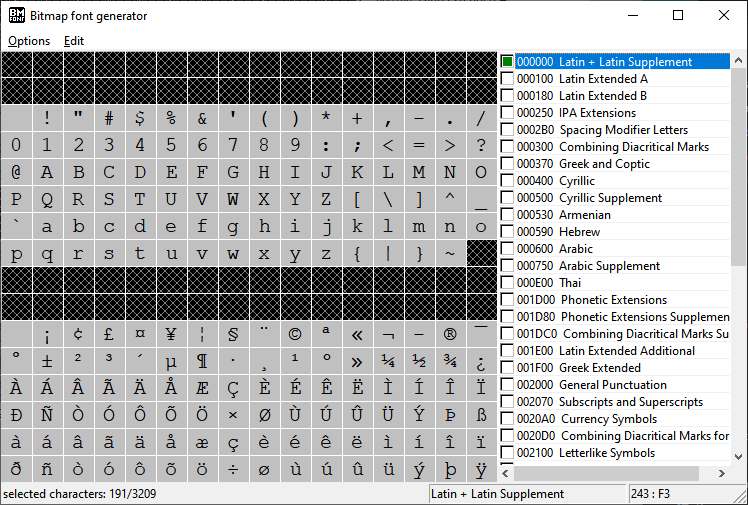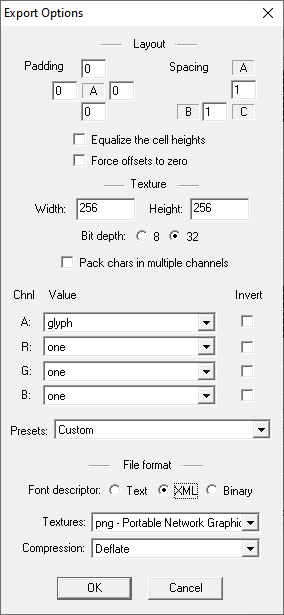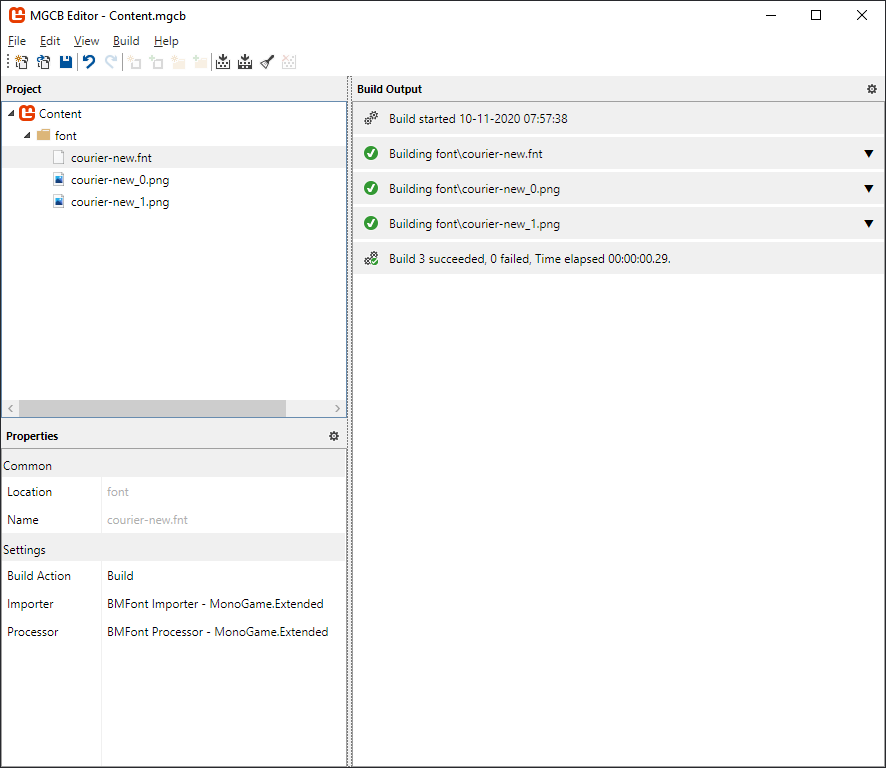Bitmap Font
This page is up to date for MonoGame.Extended 4.0.4. If you find outdated information, please open an issue.
This is an overview of the BitmapFont feature in MonoGame.Extended. BitmapFonts are font files (.fnt) created using the AngelCode BMFont format. You can generate these files with tools like the BMFont tool or alternatives such as libGDX Hiero.
In this article, we'll explore why BitmapFonts are a great alternative to the built-in SpriteFont in MonoGame. Whether you're facing limitations with SpriteFont or seeking more control over your game fonts, BitmapFonts provide a robust solution.
We'll also dive into the BitmapFont class in MonoGame.Extended, designed to act as a drop-in replacement for the SpriteFont class. You'll learn how to take the .fnt files and associated textures generated by these tools and seamlessly load them into your game, just like any other content
Installing BMFont
To generate the font files and associated textures, you'll need a tool that outputs in the AngelCode BMFont format. For this tutorial, we'll use the official AngelCode BMFont tool. Follow these steps to get started:
- Open your browser and navigate to https://www.angelcode.com/products/bmfont/.
- Click the download link for version 1.14a, which includes both x86 and x64 assemblies. This will download the bmfont1.14a.zip file.
- Extract the contents of the downloaded zip file.
After extracting the contents of the zip file, you can run the BMFont tool by using either the bmfont32.exe or bmfont64.exe executable found in the extracted directory.
The BMFont Main Window
When you first open BMFont, you'll see a screen similar to this:

This is the main window of BMFont, displaying all the characters of the font. You can click and drag over the characters to highlight or unhighlight them. Only the highlighted characters will be exported. Additionally, you can use the checkboxes on the right-hand side to select a full set from the font file, such as just the Latin characters..
Unless you need every character glyph from a font, it's recommended to highlight only the characters you'll use. This practice helps reduce the final texture size by exporting only the necessary characters.
Choosing A Font
To change the font you want to export, open the Font Settings dialog. You can do this by clicking Options and then Font Settings from the top menu, or by using the F keyboard shortcut.
In the Font Settings dialog, you can select the font you want to export, set the font size, and adjust various other settings. These adjustments will impact the texture file generated during the export process.
Once you've chosen your desired font and configured the settings, click the OK button at the bottom to close the Font Settings dialog.
Choosing Export Settings
To adjust the export settings, open the Export Options dialog. You can do this by clicking Options and then Export Settings from the top menu, or by using the T keyboard shortcut.

In the Export Options dialog, you can adjust various settings related to the export. The key settings to focus on are File Format, Texture, Bit Depth, and the Alpha, Red, Green, and Blue channel settings.
- Bit Depth: It is recommended to set this to 32 bits.
- Textures: Set this to PNG.
- File Format: Any of the available formats can be used, as MonoGame.Extended supports all three. The Binary format will produce a smaller file, but it is not human-readable like the XML or Text formats. Since manual editing of the file is typically unnecessary, using the Binary format is advisable.
For the Alpha, Red, Green, and Blue channel settings, it is recommended to use the White text with alpha option from the Presets drop-down.
You can experiment with different settings to see how they affect the output.
Once you have chosen your desired export settings, click the OK button at the bottom to close the Export Options dialog.
Generating the Export
Once you have finished configuring the Font Settings and Export Options, highlight all the character glyphs you want to export by clicking on them from the main screen. After selecting the desired characters, you can preview the final texture output by clicking Options and then Visualize from the top menu, or by using the V keyboard shortcut.
Once you are satisfied with the output, generate the export by clicking Options and then Save bitmap font as from the top menu, or by using the Ctrl+S keyboard shortcut.
Saving the font will produce a .fnt file along with one or more texture files.
Loading the BitmapFont in Your Game
Now that you have the .fnt file and textures generated, you can use them in your MonoGame project. You have two options for loading them:
- Load them directly from file at runtime.
- Use the MonoGame Content Pipeline to preprocess them and load them using the
ContentManager.
Both methods are described in the sections below.
Loading From File At Runtime
To load the BitmapFont at runtime, ensure that the .fnt file and the texture files associated with it are in the same directory. They must be in the same directory; otherwise, loading will fail when attempting to load the textures. Then you can load them using the BitmapFont.FromFile or BitmapFont.FromStream methods.
Files need to be in the built output directory. Don't forget to set the [Copy to Output Directory] to [Copy If Newer] under properties on each file (font file .fnt and bitmap file .png).
From File Example
BitmapFont bmfont = BitmapFont.FromFile(GraphicsDevice, "path/to/my-font.fnt");
From Stream Example
using(var stream = TitleContainer.OpenStream(GraphicsDevice, "Content/my-font.fnt"))
{
BitmapFont bmfont = BitmapFont.FromStream(GraphicsDevice, stream, "Content/my-font.fnt");
}
Loading Using The Content Pipeline.
To load the .fnt files using the Content Pipeline, you first need to add the MonoGame.Extended.Content.Pipeline.dll reference to the MGCB Editor. If you have not done this yet, please reference the Installation article.
Once the reference is added, you can add the .fnt file and its associated textures to the MGCB Editor. If you are using directories inside the MGCB Editor to organize content, ensure that the textures for the .fnt file are placed in the same directory as the .fnt file.

Once the .fnt file and textures are added to the project, build the content project. After that, you can load the BitmapFont using the ContentManager.
BitmapFont bmfont = Content.Load<BitmapFont>("my-font");
Rendering text in your game
MonoGame.Extended provides extension methods for the SpriteBatch that to allow you to easily render text in your game using the BitmapFont file after it's been loaded.
In your Draw method use the DrawString extension method to render text, much like you would with a traditional SpriteFont.
_spriteBatch.Begin();
_spriteBatch.DrawString(bmfont, "Hello World", new Vector2(50, 50), Color.White);
_spriteBatch.End();